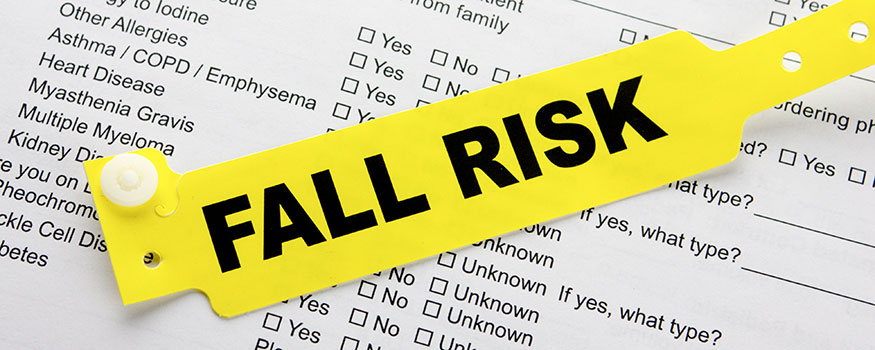In 2014, a multidisciplinary task force at Central Maine Medical Center (CMMC) in Lewiston created a fall-reduction program flexible enough to be customized to each unit’s medical specialty. The team chose the fall-prevention toolkit from the Agency for Healthcare Research and Quality as the best-practice guide against which to evaluate CMMC’s program. A comprehensive collection of best practices, the toolkit includes many items that involve a process-improvement methodology. We used some of these tools to assess the current use and effectiveness of CMMC’s fall-prevention strategies. Here we describe how we reduced our fall rate.
Analysis: Effectiveness of fall-prevention methods
The task force analysis led to development of a list of fall-prevention best practices, which the team prioritized and implemented to strengthen CMMC’s fall-prevention program. Our top three priorities were to:
• align interventions with risks identified by the fall risk assessment and adopt a universal fall-prevention philosophy
• implement post-fall huddles
• strengthen patient and family education on preventing falls in the hospital and at home.
The task force determined that the process of determining fall risk in our electronic health record (EHR) contributed to a disconnect between identified risks and selected interventions. Nurses were completing a fall risk assessment for each patient, which resulted in a risk score; the patient’s score was associated with low, moderate, or high fall risk. Then nurses developed the plan of care—essentially a list of interventions aimed at preventing the patient from falling. All too often, selected interventions failed to mitigate identified risks.
Our solution was to combine the fall risk assessment with the plan of care, linking identified risks with interventions that would mitigate them. This provided the additional benefit of streamlining nursing documentation, in turn creating more meaningful plans of care.
Fall-prevention strategies
In 2016, the task force developed the following strategies to prevent patient falls.
• Fall-safety agreement. We now use a fall-safety agreement to educate patients and family members about the patient’s individualized fall risk. Staff complete this education on admission, asking patients to sign the agreement indicating they will abide by the request to ring the call bell for assistance before getting out of a bed or chair.
• Post-fall huddle. A post-fall huddle occurs immediately after a fall, as soon as the patient is safe. The goal is to determine why the patient fell and what can be done differently to prevent future falls. The patient’s plan of care is adjusted to reflect the newly identified interventions.
• Bedside alarms in med-surg units. Alarms* were installed at each patient’s bedside in the medical, surgical, and rehabilitation units. This eliminated the problem of not having enough alarms. We created standard work (easy-to-follow, point-of-care instructions) that outlined how to use the alarm with the manufacturer’s chair pad and bed pad.
• Monthly unit fall-review meetings. These meetings, which began with the acute rehabilitation unit, are attended by frontline staff members and facilitated by the nurse manager. The goal is to review falls that have occurred on that unit and identify trends and opportunities for improvement. Currently, four of our nine inpatient nursing units have fall-review meetings.
• Shower shoes. In November and December 2015, four CMMC patients fell while showering. As a result, the task forced evaluated our showers and the showering process for environmental safety issues. We determined that our shower stalls varied in construction but essentially had the necessary safety items—grab bars and floor grips. However, patients didn’t always wear shoes. We found shower shoes we believed would help prevent slipping and required patients to wear them in the shower. Since implementing that standard we haven’t had a patient fall in the shower.
Lessons learned
On our 13-bed rehab unit, the nurse manager developed a unique approach to educating staff. She created three scenarios in which staff nurses were asked to demonstrate their ability to set up a chair alarm and bed pad alarm and to use both alarms. Staff were tested in groups of three in an unoccupied patient room.
From these scenarios, the nurse manager discovered staff didn’t recognize the importance of the alarm’s tone or its red and green lights. When staff members engaged the chair alarm but had to pause it when the patient needed to stand, they didn’t realize they needed to listen for the tone and see the green lights once the patient sat back on the chair pad to verify that the alarm was engaged. If it isn’t engaged, the alarm doesn’t work and the patient is at risk of falling.
The nurse manager alerted her colleagues of this finding so they could ensure their staff were aware of this alarm feature. If she hadn’t chosen to educate her staff in this way, she may not have identified this knowledge gap. This might seem like a small thing, but as with the shower shoes, small changes and nuggets of knowledge can make a significant difference in preventing falls.
Editor’s note: This is one in a series of recurring case studies describing success stories in preventing falls and . The series is brought to you by Posey. Watch for the next case study in the January issue of American Nurse Today.
Angela Dubuc, MSN, RN System Director of Clinical Practice Central Maine Healthcare Lewiston, Maine
